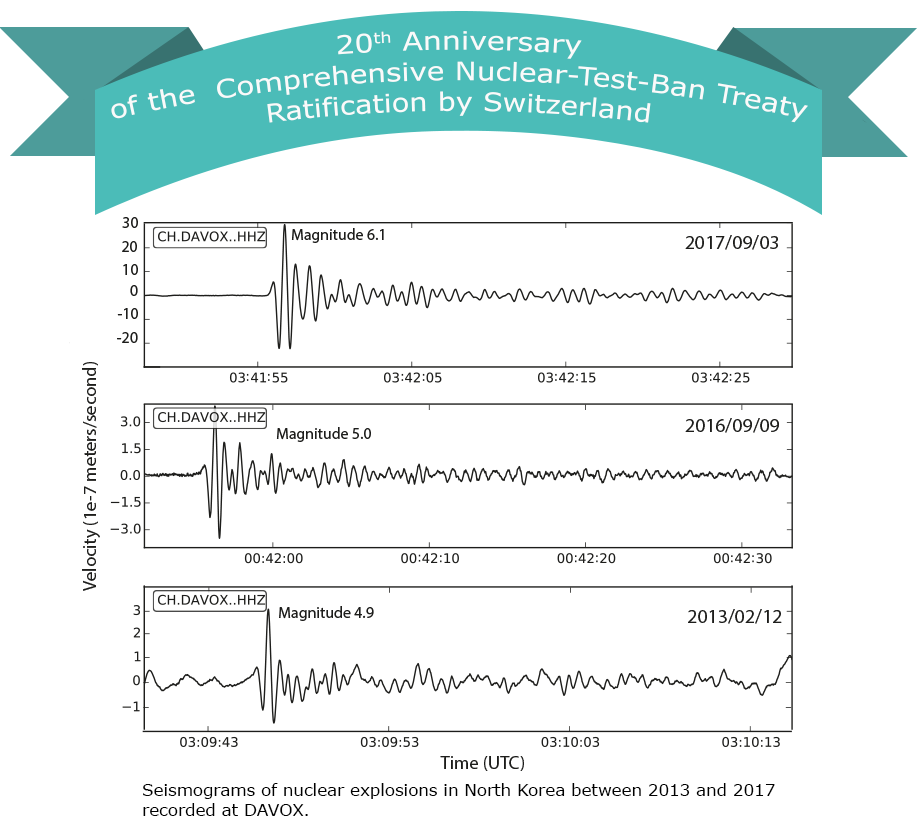2019-10-23
Twenty years of nuclear-test-ban treaty monitoring
On 24 September 1996, the first 71 states signed the Comprehensive Nuclear-Test-Ban Treaty (CTBT) at the United Nations in New York, thereby confirming that they would henceforth refrain from any future nuclear test explosions. Not only was Switzerland one of the first signatories, Geneva as a home of the United Nations also served as a hub for the preparatory negotiations. Exactly 20 years ago, in 1999, the Swiss parliament ratified the Treaty, transposing it into applicable law. So far, nearly 200 states have joined the Comprehensive Nuclear-Test-Ban Treaty Organisation (CTBTO), and 168 of them have already ratified the Treaty. For the Treaty to enter into force, eight more states would need to ratify it. They belong to the group of 44 states that had nuclear reactors in 1996 according to the International Atomic Energy Agency (IAEA).
Read more...The CTBTO is an international organisation based in Vienna that monitors compliance with the Comprehensive Nuclear-Test-Ban Treaty (CTBT). The conviction that the Treaty could be reliably monitored was crucial to its establishment. At the UN Conference on Disarmament in Geneva, diplomats and scientists held intensive discussions how such a monitoring system should look like. They agreed on a global network of highly sensitive seismological, hydroacoustic, infrasound and radionuclide monitoring stations, all linked to a common data centre. Together with the member states, the CTBTO was tasked with setting up and operating this monitoring system already before the Treaty's entry into force.
One part of this monitoring network is the DAVOX seismic station, which is run by the Swiss Seismological Service (SED) at ETH Zurich on behalf of the Federal Department of Home Affairs and the Federal Department of Foreign Affairs. The station is installed in a remote and seismically quiet location near Davos. At any suspicion of a Treaty violation, the SED immediately makes the data recorded there available to the CTBTO. The DAVOX station picked up all six of North Korea's presumed nuclear weapons tests, the most recent of which occurred in 2017. It takes about 12 minutes for the signals from explosions in North Korea to reach DAVOX as seismic waves. However, distinguishing a nuclear test from a conventional explosion also requires the other components of the monitoring system, especially the radionuclide stations. In addition to seismic monitoring, the SED actively participates in CTBTO working groups that govern data exchange, technical developments or aspects of quality control.
To mark the 20th anniversary of Switzerland's ratification of the CTBT and raise awareness of the CTBTO and the important role it plays in global security, its Executive Secretary, Lassina Zerbo, is visiting Switzerland. On 4 November 2019, he will give a lecture entitled "Science Meets Diplomacy and World Security - the Case of the Comprehensive Nuclear-Test-Ban Treaty" in the main auditorium (Audimax) of ETH Zurich. This public event will begin at 17:30. Admission is free. Please register here for the event.
A small exhibition on the CTBTO and Switzerland's contribution to nuclear-test-ban treaty monitoring will be on show from 28 October to 5 November in the focusTerra museum.
